The ATV market has
been exploding with new performance quads, and Polaris Industries
was not to be left out. While Polaris is better known in the ATV
world for their utility ATV's, Polaris has been a dominant force in
the Snowmobile racing scene for the last 12 years. Back in July
2002, we brought you a sneak preview when we captured info on a Polaris test
unit. In August we brought you our first look at the Predator 500 when we were
able to ride a pre-production unit. Since then we have been itching
to get our hands on a production unit for a more extended test. We
are finally able to bring that to you.
With
a new Predator 500 in our hands and some time to look at it up
close, one of the things that becomes apparent is that this is not
just the normal production sport quad. The Predator 500 is a
performance machine with many features you generally only find on a
race-preped quad.
|
|
|
This swingarm skid
is the best we have seen from any of the OEM's |
-
Stainless steel brake lines
-
Fully Adjustable rear shock
-
Douglas Ultimate reinforced
wheels
-
Maxxis Razr tires
-
High quality chromly axle
-
Heavy Duty swingarm skid
Just add up what those extras would cost you on
most OEM sport quads. Very impressive!
Another thing we noticed is the Predator emergency brake
setup. Most sport quads have a bulky mechanical contraption that
runs back to the rear brake. Sport quad owners end up removing it
and putting a brake block off in place. Instead Polaris installed a
setup on the front brake lever to enable you to pull in the brake
lever and lock the front brakes hydraulically. Very nice.
Seat time
Enough
looking. It was time to see how the package worked. Our test riding
took place in the sand dunes and the desert. Most all of our test
riders liked the general ergonomics of the handlebars, but the seat
takes some getting used to. It seems to have a hole in the middle
so you tend to slide forward and down into the hole. It is
comfortable in that postion but hard to shift and control the quad
in the rougher terrain. When you are riding agressively you find
yourself standing most of the time and the seat is not much of an
issue. For long trail rides the Z400 or Raptor has a much more
comfortable seating postion than the Predator 500.
Power
The Predator
500 has plenty of it. All of our riders liked the power that it
provided. The Predator easily smoked Z400s, beat stock Raptors, and
would beat many piped and jetted Raptors depending on the weight of
the rider. In the lower RPMs, the Predator does not have quite the
torque that the Raptor 660 provides and does not lug around as
well. But get after it and the dual overhead cam Fuji motor revs
nicely and the power really comes on in the higher RPMs. The 42-mm
BSR carb and the pulse fuel pump worked flawlessly during all of
our testing. At 42 HP on the Dyno the Predator has the Raptor easily
beat, but on the track the Predator loses some of that advantage
since it carries an extra 40 lbs.
Suspension
When we
first rode the Predator we were not sure we liked the suspension
very well. There was a number of things that did not feel quite
right. But thanks to the fully adjustable rear shock we were able
to take care of that. With the adjustable spring preload,
adjustable rebound, and 36 clicks of compression adjustment we were
able to get it tuned to our liking. The downside? It is so
adjustable that a novice rider could easily get it so out of whack
that they could create a very ill-handling quad.
The Predator jumps great and the suspension soaks
up the landings in supreme fashion. On the desert whoops we had
mixed reactions. The Polaris engineers created an anti-squat
suspension by design, while this helps the Predator get good starts
and get off the corners very well, it causes a problem when you are
trying to get the front to lift and skip through the whoops. The
other oddity about the suspension design was a tendency for the
rear of the quad to step out - sometimes when you least expect it.
At other times this same feature seemed to be a benefit to getting
around corners easier and quicker.
|
|
|
The Predator can throw some
knarly roosts in the sand dunes and turn on a dime when you ask it
to. |
|
|
|
|
For the sand dunes
we mounted some Sand Skate II's on Douglas red label wheels from
Rocky Mountain ATV |
|
Top Speed
With our
hand-held GPS we set out to test the top speed of the Predator. Our
test area had a very slight incline to it so we took readings in
both directions with a smaller 139 lb rider and with a heavier 185
lb rider. The lighter rider was able to reach a top speed of 73 MPH
in the uphill direction and 74 MPH in the downhill direction. The
heavier rider was only able to coax 72 MPH out of the Predator
uphill and 73 MPH downhill. One thing that both riders immediately
noticed when doing top speed testing is that the Predator 500
becomes very twitchy at 70+ MPH and feels much less stable than our
highly modified Project Desert Raptor. We think some more
caster is needed in the front suspension if you plan on spending
much time at these speeds.
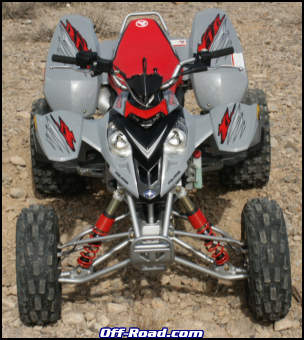 Steering
The Polaris PRO steering works
very well. The unique design puts the tie rod ends out where they
have the same pivot point as the A-arms, thus creating a design
with virtually no bump steer. The downside is you have a number of
extra parts and joints to maintain in the steering system. When on
the trail the steering provides very quick and precise control.
Each time we rode it were were amazed at how easily we could
maneuver around obstacles. (Out here in the desert those
obstacles were mostly rocks, but we suspect this steering system
will make the Polaris an excellent woods machine.)
Transmission
We
found the transmission to be a little on the notchy side, but the
ratios seemed to work good. It was nearly impossible to powershift
without the clutch in the lower gears. We found it annoying, but
then could that be by design? Maybe the Polaris engineers were
trying to avoid all the second gear failures that have plagued the
Yamaha Raptor.
Steering
The Polaris PRO steering works
very well. The unique design puts the tie rod ends out where they
have the same pivot point as the A-arms, thus creating a design
with virtually no bump steer. The downside is you have a number of
extra parts and joints to maintain in the steering system. When on
the trail the steering provides very quick and precise control.
Each time we rode it were were amazed at how easily we could
maneuver around obstacles. (Out here in the desert those
obstacles were mostly rocks, but we suspect this steering system
will make the Polaris an excellent woods machine.)
Transmission
We
found the transmission to be a little on the notchy side, but the
ratios seemed to work good. It was nearly impossible to powershift
without the clutch in the lower gears. We found it annoying, but
then could that be by design? Maybe the Polaris engineers were
trying to avoid all the second gear failures that have plagued the
Yamaha Raptor.
|
|
|
The Predator
accelerates with the best of them. |
|
|
|
|
You won't see many pictures of
people doing wheelies on the Predator. The front end likes to stay
on the ground. |
|
Other
You won't
notice them unless you ride the Predator at night, but it has some
nifty lights on the switches to tell you when you are in the "run"
position and when your lights are on bright. The Maxxis Razr tires
work very well.
Reviewer # 2 (Cliff) -
Intermediate adult
Use: desert trail and dunes
Things I
liked: The first thing that really stood out was the awesome look
and wide stance. It fires right up, warming up in no time at all,
and then it's all power from there.
The quad seemed to pull hard from the bottom all the way to the
top, reving out nicely and easily staying up with the piped and
jetted raptors on either side of me, and putting a major hurtin' on
the stock Suzuki LTZ400. I was very impressed to be riding a stock
quad with such awesome power. All I could think about was I cant
wait to ride it again after a few aftermarket mods. Then it was off
the dry lake bed and into a desert-filled whoop section. Once again
the Predator was impressive, soaking them up with no problems and
easily staying with the Raptors (equiped with expensive after
market A-arms, axles and shocks).
The
no-bump-steer engineering really seemed to do its job, as I felt no
bump steer at all. And once again the stock Suzuki seemed to fall
short in the power category in trying to stay with the larger
displacement quads. After about an hour an a half of up hills, down
hills, rocks, whoops, off-cambers and every thing else the Nevada
desert can throw at you, there were two humbled Raptor owners and a
new Suzuki owner wishing he would have held off on his quad
purchase. And one very impressed 2-stroke rider (me) who had been
given the opprotunity to ride what I feel is probably going to be
the best overall new sport quad of this year.
Then it was off to Dumont Dunes, where the Predator did
equally as well, considering it wasn't even fitted with a set of
paddle tires. It had no problems ripping up Competition Hill, or
anywhere else I wanted it to go. There were several people in
disbelief at how quick the machine was without the paddles. It was
just another great day riding the Predator! Polaris has done a
great job.
The Predator would definately be
my choice if I were looking to buy a high performance
4 stroke.
Things I didn't like: Not so much
that I didn't like these things, but they were concerns I might
have for long term reliability - I didn't care for the attachment
of the upper A-arms at the ball joints. The arms go from a
traditional wishbone and tie together as one unit before attaching
the ball joint. It just looked weak to me. Another concearn was the
lack of protection for the radiator and its overflow bottle. They
seemed to be exposed to flying objects from other quads. But
perhaps with all that power they wouldn't expect you to be
following. grin~
The only other concern I
had was plastic molded belly skid and swingarm skid. Though Polaris
is offering protection (as a lot of manufactuers offer nothing or
little at all) I don't see why alumnium skid plates couldn't
replace the cheesie plastic ones. After all they don't seem to have
cut corners any where else.
Overall
Impression: I think it's a great quad,,,,with very fun to ride
manageable power.
Reviewer # 3
(Mark) - Intermediate Adult
Things I liked: The POWER! This thing out of the crate has
exceptional power. Definitely faster than a stock Raptor. The ride
on the sand was GREAT. The no-bump-steer works great, along with
the suspension. It had a great feel of control, except the rear end
seemed to be a little light and would come around a bit too easily
in sharp turns. I would think that some adjustments to the
suspension would help with that. The controls are all in the right
places. The lighted controls were also nice for night
riding.
Things I didn't like: Although the
bike great power, one thing I did notice riding in the sand is that
on the low rpm side the bike seemed to have much less torque than
the Raptor. So when the RPM's dropped, I found myself having to
down-shift sooner.
Overall Impression /
Comments: I would say this bike has a lot over the Raptor when
comparing the two, stock to stock. We were able to run the bikes
side by side on some uphill climbs in the sand. The Predator left
the Raptor from the start and towards the end of the run the
Predator was just walking away from the Raptor. The overall feel of
the bike seemed much more stable than the Raptor as well. If I had
the choice between a stock Predator or stock Raptor, I would pick
the Predator easily.
REVIEW TEAM
SUMMARY
The Polaris engineers have
created a very impressive machine for their entry into the high
performance sport ATV segment. We think the Predator 500 is an
excellent buy at $5,999 and is closer to race ready than most of
its competitors. It is too bad they could not have added a reverse
gear. Only time will tell how well the Predator holds up. We did
not ride the Predator on the motocross track, yet this may be one
of the best applications for the Predator with its anti-dive and
anti-squat suspension.
Polaris Industries
www.polarisindustries.com
 Steering
The Polaris PRO steering works
very well. The unique design puts the tie rod ends out where they
have the same pivot point as the A-arms, thus creating a design
with virtually no bump steer. The downside is you have a number of
extra parts and joints to maintain in the steering system. When on
the trail the steering provides very quick and precise control.
Each time we rode it were were amazed at how easily we could
maneuver around obstacles. (Out here in the desert those
obstacles were mostly rocks, but we suspect this steering system
will make the Polaris an excellent woods machine.)
Transmission
We
found the transmission to be a little on the notchy side, but the
ratios seemed to work good. It was nearly impossible to powershift
without the clutch in the lower gears. We found it annoying, but
then could that be by design? Maybe the Polaris engineers were
trying to avoid all the second gear failures that have plagued the
Yamaha Raptor.
Steering
The Polaris PRO steering works
very well. The unique design puts the tie rod ends out where they
have the same pivot point as the A-arms, thus creating a design
with virtually no bump steer. The downside is you have a number of
extra parts and joints to maintain in the steering system. When on
the trail the steering provides very quick and precise control.
Each time we rode it were were amazed at how easily we could
maneuver around obstacles. (Out here in the desert those
obstacles were mostly rocks, but we suspect this steering system
will make the Polaris an excellent woods machine.)
Transmission
We
found the transmission to be a little on the notchy side, but the
ratios seemed to work good. It was nearly impossible to powershift
without the clutch in the lower gears. We found it annoying, but
then could that be by design? Maybe the Polaris engineers were
trying to avoid all the second gear failures that have plagued the
Yamaha Raptor.
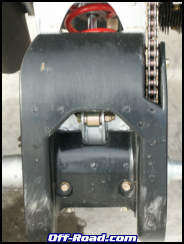
 Steering
The Polaris PRO steering works
very well. The unique design puts the tie rod ends out where they
have the same pivot point as the A-arms, thus creating a design
with virtually no bump steer. The downside is you have a number of
extra parts and joints to maintain in the steering system. When on
the trail the steering provides very quick and precise control.
Each time we rode it were were amazed at how easily we could
maneuver around obstacles. (Out here in the desert those
obstacles were mostly rocks, but we suspect this steering system
will make the Polaris an excellent woods machine.)
Transmission
We
found the transmission to be a little on the notchy side, but the
ratios seemed to work good. It was nearly impossible to powershift
without the clutch in the lower gears. We found it annoying, but
then could that be by design? Maybe the Polaris engineers were
trying to avoid all the second gear failures that have plagued the
Yamaha Raptor.
Steering
The Polaris PRO steering works
very well. The unique design puts the tie rod ends out where they
have the same pivot point as the A-arms, thus creating a design
with virtually no bump steer. The downside is you have a number of
extra parts and joints to maintain in the steering system. When on
the trail the steering provides very quick and precise control.
Each time we rode it were were amazed at how easily we could
maneuver around obstacles. (Out here in the desert those
obstacles were mostly rocks, but we suspect this steering system
will make the Polaris an excellent woods machine.)
Transmission
We
found the transmission to be a little on the notchy side, but the
ratios seemed to work good. It was nearly impossible to powershift
without the clutch in the lower gears. We found it annoying, but
then could that be by design? Maybe the Polaris engineers were
trying to avoid all the second gear failures that have plagued the
Yamaha Raptor.

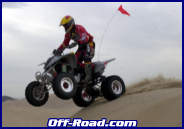
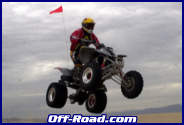
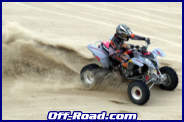
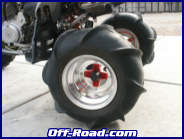
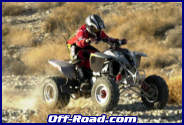
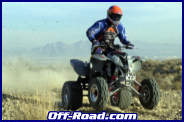

 Your Privacy Choices
Your Privacy Choices